12. Taking Stock
If a person living in 1900 were to look back, what would they see? Over the span of a century, what changes have
occurred in politics, society, or the arts? Would this perspective be significantly different for an American observer
as opposed to a British one? In Britain especially, we might encounter a culture of nostalgia, where looking back at an
idealized former age was less a matter of taking stock before a leap into the future than a lingering attempt to hold back time.
If a person living in 1900 were to look forward, what might they predict, at least in the arts? Abstraction is still a
ways off, but realism, which would be the other major force in American art, was already in full swing; we will use the
last half-hour of the class to see just how. In between, we’ll look at two iconic buildings from early in the century as
a kind of road-marker on our journey.
The script, videos, and images will be posted immediately after class.
Here are brief bios of the major artists considered in the class, listed in order of birth.
An alphabetical listing of artists for the whole course can be found at the
BIOS link on the syllabus page.
 |
Alfred Lord Tennyson, 1809–92. English poet.
Known for his lyrical poems and his Arthurian epic Idylls of the King, Tennyson was appointed Poet Laureate to Queen Victoria in 1850 and held the position until his death. He adopted his characteristic tone of elegaic retrospection relatively early, and carried it through a long career that established him as the most resonant voice of the Victorian era.
|
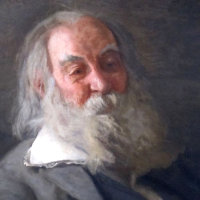 |
Walt Whitman, 1819–92. American poet.
Writing in a free verse style that would influence successors in the next century, Whitman combined a Transcendantalist philosophy with an acute observation; his later works were criticized for their overt sexuality. He worked as an army clerk and volunteer nurse in the Civil War.
|
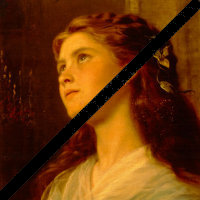 |
Sophie Gengembre Anderson, 1823–1903. French-English painter.
Born in Paris, Sophie emigrated with her parents to Cincinnati as a young woman, and there met her husband, the English genre painter Walter Anderson. She eventually settled in London with him, painting narrative subjects and idealized pictures of young women, one of which is shown here—it is not a self-portrait.
|
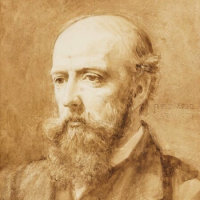 |
Philip Webb, 1831–1915. English architect.
Webb was the principal architect of the English Arts and Crafts movement, advocating traditional materials and design. He worked with Burne-Jones, the two Rossettis, and William Morris, for whom he built the Red House in Bexleyheath, a virtual manifesto of their shared principles.
|
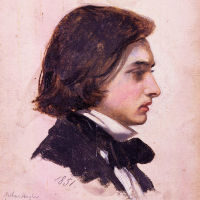 |
Arthur Hughes, 1832–1915. English painter.
As a young man, Hughes was befriended by Rossetti, Hunt, and Millais, and though he never became a member of the Pre-Raphaelite Brotherhood, he painted similar subjects in a similar style.
|
 |
Edward Burne-Jones, 1833–98. English painter.
Taking the Pre-Raphaelite style into a new phase, he specialized in elegant rather ethereal treatment of mainly literary subjects. He was a close friend of William Morris, and collaborated with him on several projects.
|
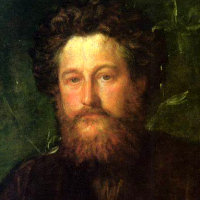 |
William Morris, 1834–96. English designer.
Morris was a textile designer, poet, and social activist, the most prominent figure in the 19th-century Arts and Crafts movement. He preached a return to simplicity, inspiration taken directly from nature, and hand-crafted rather than machine-made objects. All the same, the firm he founded to produce his designs remained a commercial force for over a century.
|
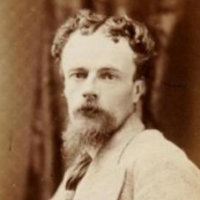 |
John Atkinson Grimshaw, 1836–93. English painter.
Although painting some literary subjects such as The Lady of Shalott, Grimshaw specialized in urban nocturnes, painting, in the words of one critic, "the rain and mist, the puddles and smoky fog of late Victorian industrial England with great poetry."
|
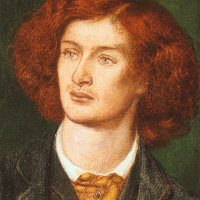 |
Algernon Charles Swinburne, 1837–1909. English poet.
Swinburne is usually remembered as a poet, though he also wrote novels, plays, and criticism. He was unafraid to treat deviant sexual subjects, which aligns him with the Decadent school in England and France. His work includes two poems about Proserpine in 1866.
|
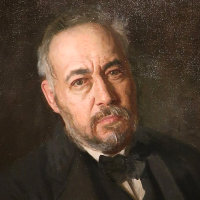 |
Thomas Eakins, 1844–1916. American painter.
Philadelphian Thomas Eakins is now counted among the greatest American-born painters of the 19th century, but in his day he was ridiculed for his insistence of realism in his portraits and scenes from everyday life. His legacy lives on, however, in the work of the Ashcan School and other painters at the turn of the century who began to give American art a distinct national style.
|
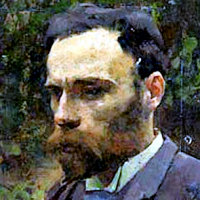 |
John William Waterhouse, 1849–1917. English painter.
Beginning in an academic manner, he became drawn to Pre-Raphaelite style and subjects, with illustrations from Shakespeare, Greek myth, and Arthurian legend.
|
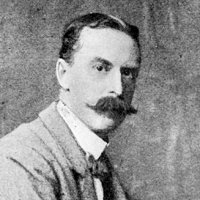 |
Edmund Blair Leighton, 1853–1922. English painter.
A late follower of the Pre-Raphaelites, Leighton specialized in narrative subjects from history or myth. Although a member of a family of artists, he was apparently unrelated to Frederic Leighton.
|
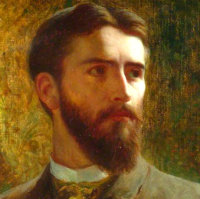 |
Frank Dicksee, 1853–1928. English painter.
Sir Francis Bernard Dicksee was the son, brother, and cousin of successful painters. Like his father, he had a particular interest in literary and historical subjects. He became President of the Royal Academy in 1924.
|
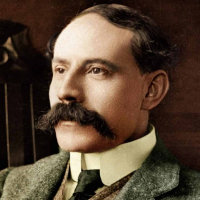 |
Edward Elgar, 1857–1934. English composer.
Elgar was the leading figure in English music during the late Victorian and Edwardian eras. With works such as the Enigma Variations and his concerti for violin and cello, he was one of the first English composers after Purcell to achieve an international reputation.
|
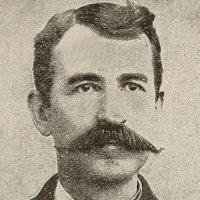 |
Edward Taylor Paull, 1858–1924. American composer.
Paull "was a minor American composer, arranger, and sheet music publisher" [Wikipedia]. He specialized in marches.
|
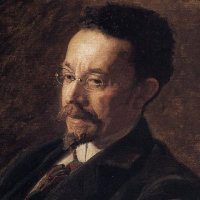 |
Henry Osawa Tanner, 1859–1937. American painter.
Born in Pittsburgh, Tanner trained in Philadelphia then moved to Paris in his early thirties, achieving early success in Biblical subjects exhibited at the Salon. He and his wife (also American) settled in France for the remainder of their lives. The recipient of an honorary Légion d'honneur, Tanner is notable as the first African American artist to achieve international renown.
|
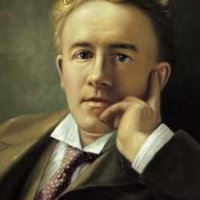 |
Edward German, 1862–1936. English composer.
Born German Edward Jones to a Welsh family in the West of England, he took his given names as a nom de plume when he began to achieve success as a composer of incidental music for the theater and light operas in the Gilbert-and-Sullivan vein, such as Merrie England (1902).
|
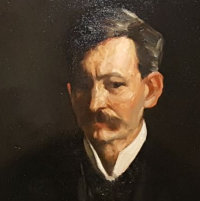 |
Robert Henri, 1865–1929. American painter.
Clearly a charismatic leader and teacher, Henri's contribution to American art may rest more in the roster of artists he influenced—in the Ashcan School but also beyond—than in his own work. A realist at heart, he did much to combat American conservatism around the turn of the century. The name is pronounced "HEN-rye."
|
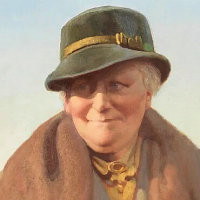 |
Beatrix Potter, 1866–1943. English writer.
The author and illustrator of 23 highly successful children's books, beginning with Peter Rabbit in 1902, Potter also published around 40 other books, achieved a scientific reputation as a mycologist, and later as an environmentalist, buying several farms in the Lake District adjacent to her own to preserve the landscape. Her registration of Peter Rabbit as a doll and license of her characters in other media made her a pioneer of character merchandising as an entrepreneur.
|
 |
Ernest Dowson, 1867–1900. English poet.
Dowson's parents both killed themselves while suffering from tuberculosis, and he himself was tragically short-lived, dying in poverty. A poet associated with the Decadent movement, he is remembered mainly for two phrases: "Days of wine and roses" and "I have been faithful to thee, Cynara, in my fashion."
|
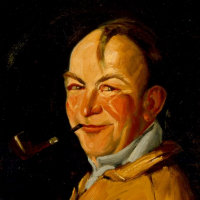 |
George Luks, 1867–1933. American painter.
Luks was born in Pennsylvania to Polish and German immigrant parents. He began his career in vaudeville, then found success as a newspaper cartoonist. Turning to painting, he became a member of the Ashcan School, producing mainly crowded urban scenes, slightly exaggerated, but full of vigorous life.
|
 |
Frank Lloyd Wright, 1867–1959. American architect.
Wright designed over 1,000 buildings, including the iconic Fallingwater (1937) and Guggenheim Museum (1959). Beginning with the Ward Willits House in Chicago (1902), he developed what became known as the Prairie School of architecture, featuring long low verticals and close integration of buildings with their environment, principles that he developed further in connection with Broadacre City, a pioneer of planned suburban development.
|
 |
Scott Joplin, 1868–1917. American composer.
Though he began playing in the brothels of Saint Louis and Chicago, Joplin had already received a good musical education with the support of his mother. He made his name writing and performing piano rags, earning him the title "The King of Ragtime." His operas The Guest of Honor (now lost) and Treemonisha (1911) received little attention at the time, but the latter was revived to great acclaim in Houston in 1976.
|
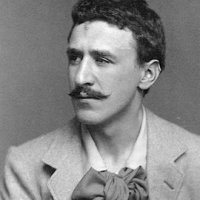 |
Charles Rennie Mackintosh, 1868–1928. Scottish architect.
Born in Glasgow and trained at the Glasgow School of Art (whose new buildings he later designed), Mackintosh developed a European reputation as one of the leading architects of the art nouveau movement. Unfortunately, few of his buildings (often executed in collaboration with his wife, Margaret Macdonald) now survive intact, and his career dwindled to almost nothing around the time of WW1.
|
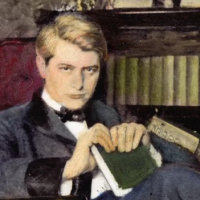 |
Frank Norris, 1870–1902. American writer.
Norris studied painting for two years in Paris, but the influence of the realist novels of Zola caused him to take up novel-writing as a profession. He produced McTeague (1899) and several other works critical of the capitalist society, before dying of a ruptured appendix at the age of 32.
|
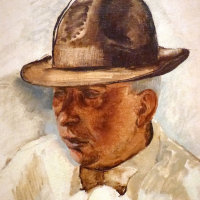 |
Theodore Dreiser, 1871–1945. American writer.
Dreiser was a journalist and realist novelist best known for Sister Carrie (1900) and An American Tragedy (1925). His novels feature characters who abandon traditional moral codes; they themselves may succeed, but they leave tragedy in their wake.
|
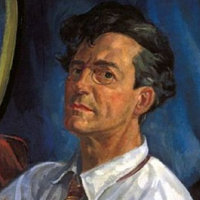 |
John Sloan, 1871–1951. American painter.
Sloan was one of a number of realist painters in New York in the early 20th century popularly known as "The Ashcan School" because of their fondness for less elevated subjects. Sloan himself was a committed Socialist.
|
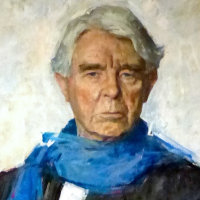 |
Carl Sandburg, 1878–1967. American poet and biographer.
Sandburg won two Pulitzer Prizes for his poetry and one for his biography of Abraham Lincoln. He began his writing career as a journalist on the Chicago Daily News, and many of his poems paint a realistic, but basically optimistic, portrait of city life.
|
 |
Arthur Dove, 1880–1946. American Painter.
Dove, who spent some time in France in the ferment of the first decade of the century, is credited with painting the first abstract pictures in America, although he did not exhibit them at the time.
|
 |
George Bellows, 1882–1925. American painter.
A leading member of the Ashcan School, and known for his scenes of city life and boxing, Bellows was a pupil and close associate of Robert Henri. At 27, he was the youngest artist ever to be elected to the National Academy of Design.
|
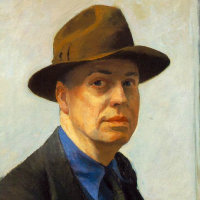 |
Edward Hopper, 1882–1967. American painter.
In all his career, Hopper maintained a balance between the social realism of his teacher Robert Henri, and the simplified forms of the abstraction that came into play soon after. Painting almost exclusively scenes from contemporary life, he managed to universalize the specific, and give everyday situations a powerful aura that transcended their literal subject.
|
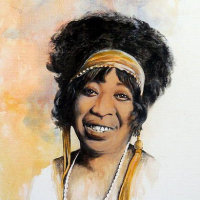 |
Ma Rainey, 1886–1939. American blues singer.
Born Gertrude Pridgett, and performing since her early teens, she became known as "Ma" Rainey after her marriage to Will "Pa" Rainey in 1904. They toured together, performing blues songs, many of which were her own compositions, including the standard Ma Rainey's Black Bottom. As one of the first blues singers to record (beginning in 1923), she earned the title "Mother of the Blues."
|
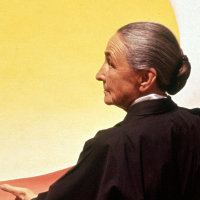 |
Georgia O'Keeffe, 1887–1986. American painter.
Her near-abstract enlargements of flower and plant forms established her as a pioneer of American modernism. She settled in New Mexico for the last 40 years of her life, adding desert landscapes and bleached skulls to her repertoire of forms that she would revisit in numerous variations.
|











































































